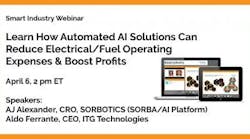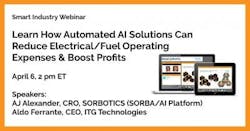Webinar Preview: How automated AI solutions can reduce electrical/fuel operating expenses
Smart Industry: What is one example of a quick / simple way of deploying AI automation to reduce operating expenses?
AJ & Aldo: A subset KPI was achieved recently for a global F&B client of ours by reducing their fuel consumption in their kilning production process. A desired level of quality outputs associated with maintaining an optimal malting batch product profile needed to be taken into consideration when deploying edge based AI advance process control (APC) models to reduce energy consumption. With this notion in mind, lab data comprised of key moisture, temperature and wort color variables were collected and analyzed manually by several technicians days batches of product are produced. We could classify this procedure as reactive quality control input critical to achieving our APC objective.
To perform any automated quality tests, driven by AI, that augments an engineer’s roles, you must first capture the pass/fail decision making logic made by a lab technician as well as any supporting indicators used for quality inspection. Factoring this logic into the application, the customer/user, whom at the time was a SME of the batch recipe, was able to create a real-time digital twin ML model of the quality data historized over a short amount of time, predicting a simulated optimal quality profile of the malting product being produced maintained in the safety specified process guardrails, based on current demand on hand, as the APC models in a parallel function are performing their optimization objective of controlling the air flow and fan speed instrumentation to reduce gas usage.
This reduction in operating expenses is defined by the customer now being equipped to perform automated quality testing procedures that decreases overall labor run time by offloading several inspection tasks handled by the SORBA digital twin model in addition to reducing the costly time spent performing slower subjective inspections that leave room for human error. What’s not being taken into account are the potential rippled affects from this raw material production outfit that serves as a downstream process within a global supply chain of external manufacturers that can’t afford to receive quality deficient product. This is an example how AI can be married with the operations SME to offset tedious or simple tasks that once were performed by teams of highly trained technicians but is now captured in the form of an AI/ML model. Operational and production ready edge AI can enable experts to focus their tribal knowledge on higher valued problems and tasks thus providing a measurable reduction in COGS that are compounded over the lifecycle of that deployed APC model closed loop reducing kilning fuel consumption.
Smart Industry: What do you mean by "democratizing AI solutions"?
AJ & Aldo: A consumerization of readily available analytic solutions and production ready apps, similar to the likes of an apple iTunes store, can be defined as a democratized AI solution. Digitalization teams for manufacturers across the globe are currently residing in the Gartner Hype Cycle’s AI/IIoT trough of disillusionment. This harsh reality is the subject of many popular discussions within C-Suite manufacturing circles discussing how feasible it is to deploy AI to solve hidden business problems in order to increase bottom line profits.
The disconnect between a costly yet well-educated promising data scientist and a production line SME with 20+ years of tribal knowledge is real with the understanding that the data scientist today still relies heavily on an operator input to the modeling process in addition to validating the viability and performance of the deployed ML model that is “suppose” some function of the business. The research says for every 1 data scientist on staff an organization will require hiring an additional 5 data/feature engineers to deploy a single model. The total cost of ownership of that math is not scalable by any means.
So the concept of democratizing AI solutions is to equip front line workers in manufacturing environments with edge based AI/ML automated tools that can leveraged and implemented faster and more affordably to scale solutions across the enterprise. The most effective way to reduce the time to value curve in any AI implementation leverage internal skills that brings the basic data science expertise in-house, couple with domain knowledge, that generates advance industrial analytics while minimizing the burdens of an evident total cost of ownership equation. Process/Reliability engineers and maintenance technicians can fill the role of citizen scientists and democratize AI solutions at scale. This new developed skill set can derive more value from previous analytics solutions they are using, as well as dig more deeply and broadly into data made available to them.”
Smart Industry: How is Auto-ML equipping manufacturers to deploy production ready ML algorithms to the plant floor?
AJ & Aldo: The reality is Machine Learning is a difficult practice and requires a high degreed multi-disciplinary proven track record. In each step of the ML process, data scientists make choices that will impact the results or outcomes is what makes deploying AI/ML so convoluted and fuzzy. Unfortunately, there is no handbook for dummies guide for the labor-intensive, sometimes costly, decisions of model selection and configuration, hyperparameter optimization, etc. AutoML is an innovation in AI realm that automates majority of manufacturing data science tasks and development lifecycles in addition to providing a continuous feedback loop/interpretation to the data scientist on the performance of their data pipelines currently in production. Auto-ML adapts to the optimization process of the Machine Learning Pipeline process in real time and provides recommendations for model, process and hyperparameter selections. Gartner is predicting by the end of the year more then 50% of a data scientist role will be fully automated meaning an plant engineer can take on this skillset and skip the PhD academia prerequisites in order to tackle everyday operational pain points in the production process. The stages in the below table are often times packaged together like a McDonalds happy meal through integrating a mix bag of expensive 3rd party software packages, cloud infrastructure pieces and consulting vendors.
The following stages of an Auto-ML pipeline are now optimized for manufacturers and made available through a serverless edge based web configuration wizard. AI/IIoT in a box is the concept being coined.
|
Process |
30k ft. View Description |
Auto-ML Production Application |
|
Edge Data Preprocessing |
Data is processed, cleaned, formatted and transformed before the Machine Learning Model can be trained on it. |
Automatically choose pre-processing model. |
|
Model Selection per the production problem at hand |
The Machine Learning Model is selected from the dozens of possible popular Machine Learning models per problem type. |
Automatically choose Machine Learning model for specific dataset according to some performance metric (accuracy, time or memory consumption). |
|
Hyperparameter Optimization (the nerdy mechanics of AI) |
A set of optimal Model hyperparameters (i.e., dimensionality reduction rates, different learning rates, constraints, data balancing weights, forecasting/lag horizons etc.) is selected for a Machine Learning Model from among endless possible configurations…whose got time to figure all this out? |
Automatically choose and ensemble possible Model hyperparameter configuration from among thousands of possible configurations in order to achieve maximize results with the best score not focused on 99% accuracy but optimal enough to be deployed and make predictions etc. |
Smart Industry: What most excites you about new possibilities in this area?
AJ & Aldo: Most of the manufacturer’s reading this content will revert back to a simple yet philosophical question on how exactly does this technological wave of Industry 4.0 solutions ultimately improve my organizations global OEE metrics at the end of the day. There has never been a time in our industry where the sci-fi notion of AI/ML augmenting manufacturing environments to become more efficient in doing more with less by monetizing data strategies. Being able to debunk that notion and practically demonstrate/implement the mechanics of deploying AI/ML to solve business problems that were once perceived as unsolvable is what excites me the most about this area of manufacturing!
Applying machine learning in manufacturing to improve OEE is not just a technology implementation, it also requires a culture change and organizational mind shift to committing in becoming digital first. The steps of becoming a data-driven manufacturer with the application implementing ML predictions not only requires the trust of the enterprise as a whole but also the dedicated time to train and integrate the models into the everyday tried and true manufacturing workflow processes and SOP’s.
The adoption of ML to drive efficiencies should be a top down strategy with key champion stakeholder buy-in. Otherwise, there is a very high probability of that AI initiative from failing. I didn’t need an ML model to derive that insight.
With any industrial organization, the application of ML also requires a new skill set, which manufacturers have historically not possessed, that is, the role of becoming a “citizen data scientist.”
This role is to interpret the data and train the models but can’t be done in isolation and needs fully operational support from the experts across all OT/IT business groups in order to be successful in addition to providing them the business context support required to understand the data. This will alleviate the potential stresses and nuances of being unequipped with the sufficient IT tools and infrastructure to get to the right data in order to train confident problem solving ML models deployed into production. Ask any data scientist and they will tell you that deploying a model into production is always the largest hurdle to overcome.
Plan to succeed, and choose production pilot use cases that are manageable, show measurable not inflated ROI metrics (from PLC to P&L) and have a clear scalable path to production. There is no point choosing a use case to apply AI/ML to identify defects if a human can’t detect the defect currently through traditional rules based measurement methods.
A successful implementation of machine learning will only come about by having an organization that is ready to embrace a new culture. Get VP or C-level buy-in, have the willingness to experiment, show value in a PoC production environment, and then scale out for success. The output results must be benchmarked against specific business objectives and success criteria metrics to show the value of machine learning. Dream big but start small!




